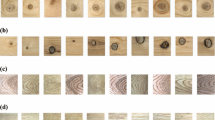Abstract
We used principal component analysis (PCA) and compressed sensing to detect wood defects from wood plate images. PCA makes it possible to reduce data redundancy and feature dimensions and compressed sensing, used as a classifier, improves identification accuracy. We extracted 25 features, including geometry and regional features, gray-scale texture features, and invariant moment features, from wood board images and then integrated them using PCA, and selected eight principal components to express defects. After the fusion process, we used the features to construct a data dictionary, and realized the classification of defects by computing the optimal solution of the data dictionary in l 1 norm using the least square method. We tested 50 Xylosma samples of live knots, dead knots, and cracks. The average detection time with PCA feature fusion and without were 0.2015 and 0.7125 ms, respectively. The original detection accuracy by SOM neural network was 87 %, but after compressed sensing, it was 92 %.








Similar content being viewed by others
References
Candes E (2006) Compressive sampling. Proc Int Congr Math 3:1433–14521
Castellani M, Rowlands H (2009) Evolutionary artificial neural network design and training for wood veneer classification. Eng Appl Artif Intell 22:732–741
Donoho D (2006) Compressed sensing. IEEE Trans Inf Theory 52(4):1289–1300
Estévez PA, Perez CA, Goles E (2003) Genetic input selection to a neural classifier for defect classification of radiata pine boards. For Prod J 53(7/8):87–94
Gu IYH, Andersson H, Vicen R (2008) Automatic classification of wood defects using support vector machines. In: Computer vision and graphics: lecture notes in computer science, vol 5337. Springer, Berlin, pp 356–367
Peck R, Devore JL (2005) The exploration and analysis of data. Duxbury Press, Belmont, pp 611–662
Pham DT, Alcock RJ (1998) Automated grading and defect detection: a review. For Prod J 48(3):34–42
Pham DT, Alcock RJ (1999) Automated visual inspection of wood boards selection of features for defect classification by a neural network. Proc Inst Mech Eng Part E 213(4):231–245
Ruz GA, Estevez PA, Ramirez PA (2009) Automated visual inspection system for wood defect classification using computational intelligence techniques. Int J Syst Sci 40(2):163–172
Shi GM, Liu DH, Gao DH, Liu Z, Lin J, Wang LJ (2009) Advances in theory and application of compressed sensing. Acta Electron Sin 37(5):1070–1081
Zhang YZ, Cao J, Xu L, Yu HL (2013) Wood floor defects segmentation and recognition based on morphological and SOM. Electr Mach Control 17(4):116–120
Zhang YZ, Liu SJ, Cao J, Li C, Yu HL (2014a) A rapid, automated flaw segmentation method using morphological reconstruction to grade wood flooring. J For Res 25(4):959–964
Zhang YZ, Xu L, Ding L, Cao J (2014b) Defects segmentation for wood floor based on image fusion method. Electr Mach Control 18(7):113–118
Acknowledgments
This work was financially supported by the Fund of Forestry 948 Project (2011-4-04), the Fundamental Research Funds for the Central Universities (DL13CB02, DL13BB21), and the Natural Science Foundation of Heilongjiang Province (C201415)
Author information
Authors and Affiliations
Corresponding author
Additional information
The online version is available at http://www.springerlink.com
Corresponding editor: Yu Lei
Rights and permissions
About this article
Cite this article
Zhang, Y., Xu, C., Li, C. et al. Wood defect detection method with PCA feature fusion and compressed sensing. J. For. Res. 26, 745–751 (2015). https://doi.org/10.1007/s11676-015-0066-4
Received:
Accepted:
Published:
Issue Date:
DOI: https://doi.org/10.1007/s11676-015-0066-4




